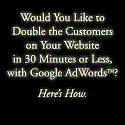

How To Craft A Compelling Offer In 7 Easy Steps by Yaro Starak
I was just reading this blog post by Yaro Starak about crafting offers and found it so very insightful. It too gave me a real refresh of how to do this well. He talks about Eben Pagan’s Guru Blueprint which Yaro studied in order to refresh his understanding on crafting a solid offer. Leave your comments if you have anything you thing needs to be added to this awesome blueprint for crafting a compelling offer.
At the moment I’m madly running around in an attempt to put together a page to promote the workshop Alborz Fallah and I are running in October in the USA. If you are interested in attending I’ll have full details for you very soon…as soon as I get the page up!
There are two things I need to complete in order to finalize the page.
- The location for the workshop. It’s going to be in New York City in October, and I think I’ve just found a venue to host it, so this is almost sorted.
- The sales page video that tells you about the event.
Alborz and I began filming the video footage last week and managed to record some very good blooper reel content, but nothing we could actually use (we did have lots of laughs though!).
I realized one of the main reasons we had such an unproductive day was that I didn’t have a good enough plan for what the video should contain. I went back to some of my study materials and cheat sheets on how to construct a good offer to refresh my memory.
I came across a video from Eben Pagan’s Guru Blueprint course which gave me the reminder I needed. The video wasn’t too long, about 20 minutes, but had a really simple 7 step formula for coming up with an offer. I’ll share it with you in a moment, but first let me explain what exactly an offer is.
What Is An Offer?
An offer is the final place where you tell your potential customers what you are offering them in exchange for their money. It might be a sales page, or a sales video or a pitch on stage at an event or on a live webinar. Whatever the format, the content remains much the same and there are some key points you should cover to help increase your likelihood of making a sale.
I previously became very confused about what exactly an offer is. I thought it was just the buy button on a sales page or simply saying you get this if you give me X amount of dollars. I later learned that an offer is a lot more than that. It includes the obvious component – a price and a mechanism to make the transaction – but it also includes other important things like price justification, risk reversal, background story and other marketing elements.
The offer is absolutely critical because it’s the final piece of marketing your prospect experiences before making a purchase. You might lead them towards an offer with all kinds of different marketing tools, but the offer is the final conclusion.
In the case of the video I am making now, Alborz and I are relying on our reputations, personal case studies, record of results and established relationship with you as key components of our offer. That means the video has to explain a lot, which is why having a framework or even just a checklist, is helpful.
7 Steps To Craft A Good Offer
I’m not going to repeat word for word what Eben teaches. You can take one of his courses if you want his break down. That being said, these are not strictly Eben’s ideas either, he’s taken what he learned from other people, in particular copywriters like John Carlton, and come up with his interpretation.
In the spirit of interpretation, here is my take on the 7 steps, which you can use to craft an offer for your next product.
1. The headline.
This is the element that encapsulates what your product does in a brief sentence or two. It should focus on the core emotion driving your potential customer to make the purchase, and must be clear about specific outcomes. Like writing headlines for blog posts, this is the most important element because it’s the initial attention grabber. For a video offer, I consider what you say in the first 30 seconds equivalent to the headline, or you can include headline text above the video to entice people to click the play button.
2. Set up the scenario and explain the challenge the customer is up against.
In this section you frame what the potential customer is facing and what experiences most people have when trying to achieve whatever your product helps them achieve. This is where you demonstrate you know the problem or desire the potential customer has better than they do. This is very powerful because it shows your intimate knowledge of the situation and that infers you might have something that actually works, because you know so much about what doesn’t.
3. Tell your story.
I’ve relied heavily on this element in many of my offers when it comes to teaching how to make money online with blogs and membership sites. If you’re teaching how to do something or how you went through an experience to come up with your product, going through the before and after story is very powerful. It helps to hook the prospect in because stories are the most compelling content you can create. As you tell the story you should point out your ah-ha moments and how you came up with certain techniques or solutions that no one else uses.
If you don’t have your own story, or even if you do, telling the story of other people works well too. Adding some case studies of previous customers or people who have benefited from your work is a very good idea and another technique I’ve used many times before. Testimonials are good, but stories from other people who were just like everyone else with a problem that you helped them solve with your product, are much better.
4. Dish out a list of the benefits of your product using specific and tangible results.
Eben suggest you come up with twenty dot points you list out of all the amazing things your product or service does, focusing on tangible outcomes and specific problems (avoid abstract concepts like “you will feel better” – instead use phrases like “You will lose ten pounds and be able to play tennis again”). This is a good chance to touch upon sticking points that your prospects might have. If your prospect sees just one point that strikes a nerve that they simply must know about, this could be the trigger that convinces them to buy.
5. Next you state the price, but you don’t just lay it out there, you justify it by demonstrating how much incredible value you are delivering.
Eben recommends you focus on showing how you are charging just 10% of the value you are delivering, for example pointing out that you charge X dollars for private coaching, yet this product costs just a fraction of that. This is a good time to include bonuses, which as Frank Kern calls it – you “stack the cool” – including so many relevant and exceptionally valuable additions to your core product that people can’t help but say yes.
6. The Risk Reversal.
This is where you tell prospects that there is no risk buying because they are protected by a guarantee. The risk is then placed on you to deliver, since they can ask for their money back if they don’t like it. Of course you plan to over-deliver, so this is a win-win, your prospects are protected so compelled to buy, and you are committed to delivering a great product.
7. The Call To Action.
This is straight forward, yet needs to be very specific. Tell your prospects to buy by saying do this (e.g. click the buy button), then this will happen (e.g. you will be directed to our secure order form where you will make payment via credit card or paypal) and then this (e.g. you will receive a confirmation email within a few minutes of processing your order).
Don’t just say “please buy now”, tell them how to do it and say do it now. This needs to be explained as if you are teaching someone how to use the computer for the first time.
Obviously these points can each be dissected to much more depth, but this list is a good starting point. I recommend if you want more details on what to include in a sales page but you don’t have money to invest in a full course on copywriting, try Alexis Dawes Desperate Buyers Only ebook, which you can find my review of here and costs under $100.
I need to get to work and start compiling my answers to these seven points for the New York workshop with Alborz I will be offering you very soon. It looks like we will have about 10 spots available, so stay tuned if you want to come hang out with us in October.
Yaro Starak
Crafting Offers
Taken from: http://www.entrepreneurs-journey.com/3296/how-to-craft-an-offer-in-7-steps/
Facebook comments:
1 Comment »
RSS feed for comments on this post. TrackBack URL
Leave a comment
















October 9th, 2010 at 4:53 am
While I cannot disagree with anything you have shared here, one caveat comes to mind. Doesn’t a product category also define a workable niche? In other words when a product category is broken down to its simplest elements are you not defining a niche or audience based on common likes and or dislikes of that product category? And the demographics of these people sharing interest in these products defines the audience.
I am way new at this so maybe my thinking is backward, but right now it makes perfect sence to me.